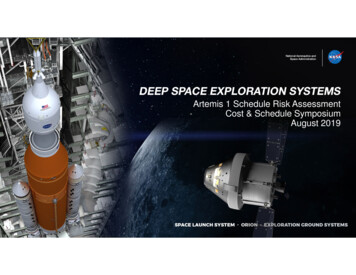
Transcription
Artemis 1 Schedule Risk AssessmentCost & Schedule SymposiumAugust 2019
Schedule Risk Assessment (SRA) Goals & AgendaAugust 2019GOALS2This brief covers methodologies and lessons learned in a successful effort to developan integrated Schedule Risk Assessment for Artemis 1 for other programs to leverageProgram results and inputs are not shownAGENDA Artemis 1 OverviewEnterprise Schedule Risk Assessment Summary & ImpactModeling TechniquesSRA Results Briefing FormatLessons LearnedQuestions & Discussion
Artemistext]1 Mission Overview (Previously EM-1)[headerAugust 20193Artemis 1 will be the first integratedtest of NASA’s deep spaceexploration systems: the SpaceLaunch System (SLS), Orionspacecraft, and Exploration GroundSystems (EGS).The three programs are integrated atthe enterprise level.Artemis 1 is focused on successfullaunch, orbit of the moon, and saferecover of the unmanned crewcapsule.Artemis 2 is a planned crewedmission.Artemis 3 is a planned lunar landing
Artemis Organizational Structure & SRA ContributorsAugust 20194Exploration Systems Development (ESD)SLS Keith HeitzmanJacquelyn GowerMark BryantJoe HatchettSteve PattersonMike SelfMinda AlexanderJohn IsomEGSOrion Ethan Miller Mike Stelly Nate RychlikTrey ReillyAntonio RippeStan HobackJoy MosdellDavid PierceGlenn Vera Tonya McnairTom RathjenHeide BorchardtKelly MosesAidan FlatteryLaura Emerick KrepelAshley PeterMaddy SacripantiChris McKelveyThomas BeardMichael CallEric BoulwareJustin HornbackStephen BauderDan Mulligan The Exploration Systems Development (ESD) organization is responsible for managing and integrating the threeprograms (SLS, Orion, & EGS) developing the specific capabilities needed to support deep space exploration The programs conduct their own schedule assessments which are leveraged alongside ESD analysis for this effort
Enterprise Schedule Risk Assessment SummaryAugust 20195AccomplishmentsApproachInitial BuildIntegratedModelIndependentEvaluation Independent evaluation by Developed high level Developed more detailedOCFO Strategic Investmentintegrated model with smallmodel with programDivision (Pirtle & King)team (4) and existing dataschedulers, risk managers, and Performed Oct 2017- Jananalysts2018 Integrated data from individualprogram’s SRAs Briefed and shared resultswith leadership & broaderteam for detailed feedback SID positively assessed: Culminated with a brief to allo Program & Enterpriseprogram managers at the Nov2018 Quarterly Program Statusschedule managementReview (QPSR) in a closedpracticesdoor executive sessiono SRA uncertainty & riskassessmentso Management use of SRAQuarterlyUpdates & Evals Update quarterly or as required Continually refine & improve modeling Performing what-ifs & deep-dives Consistent updates allow for clearinsight into the impact of ongoing riskmitigation efforts Regular leadership briefing ofupcoming high-risk schedule areasand probabilistic critical paths Shifted discussion from the modelinputs & results into managementactions, the “Now What” Senior NASA Leadership has called the Artemis 1 SRA the “gold standard” in NASA Management is using the SRA to inform schedule planning, decision making, and contractor management
Schedule Risk Assessment OverviewPre-Decisional: Internal NASA Use OnlyAugust 20196Output & ResultsInput & AnalysisSchedule IMS or higher-level analysis schedule Logically driven Compatible with MS Project or Primavera P6Monte Carlo(Polaris)Duration Uncertainty Bounds Min, max & most likely durations of activitiesRisksX 1,000 – 15,000Simulation Runs Probability of occurrence Cost & schedule impacts if realize Impact mapped to schedule taskCorrelation, other inputsResult is a probabilistic finish date50 % chance of finishing by 70 % chance of finishing by Schedule Risk Assessment quantifies the combined impact of duration uncertainty and project risks.It provides predictive and actionable programmatic insights and data confidence.
SRA Modeling Techniques
Modeling TechniquesAugust 20198A range of modeling techniques have been utilized based on the data available at each program Discrete Event Simulation (DES): Utilized the outputs from detailed program DES modeling. The DES model further incorporatedinput from historical data, subject matter experts, and historical learning curves Historical Milestone Trending: Trended historical performance data for the period available and identified the average rate ofchange (slip rate). Forecasted this rate of change forward to estimate delivery dates Earned Value Management (EVM) Data: Used program earned value data as a basis to construct uncertainty estimatesUncertainty estimates were generated using the earned schedule technique Historical Performance Ratio: Evaluated completed analogous activities from detailed program schedules, analyzing their actualduration / baseline duration Regression: Evaluated actual duration versus baseline duration for comparable activities Subject Matter Experts (SMEs): Incorporated duration uncertainty estimates from enterprise and program SME’s Other Performance Data: Evaluated performance in terms of job burndown and Agile Point burndownIdeally, multiple modeling methods can be used in order to compare and understand the impact to results
Existing Enterprise Schedule is the Basis for the SRAAugust 20199THE INTEGRATED ENTERPRISE SCHEDULE, KNOWN AS THE ECS1: Is a cross-program analysis schedule that is based on a summary of each ofthe three program’s integrated master schedules Is statused on a monthly basis by each of the programs and maintained &evaluated by the enterprise Programmatic & Strategic Integration ScheduleAnalysis Team (PSAT) Serves as the basis for agency integrated reporting including critical pathanalysis, delay evaluation & what-ifs ECS to SRA Analysis ScheduleLeverage a consistent calendar (we used 7days, no holidays)Removed completed activitiesOmit items that are not expected to be oncritical path to reduce model validation timeMinimize the use of short-duration activities inPolaris due to rounding to whole days Serves as the basis for both the ESD and SLS schedule risk assessmentsSID confirmed that the ECS is an accurate representation of the programs’ IMSs and lower level schedules1ECS Enterprise Cross-Program Integration Team Schedule.
HistoricalMilestone Trending[headertext]August 2019 Collected historical data for key delivery milestones andgenerated a trend line surrounding this Calculated the average rate of change (slip rate) over thegiven time series Used the average rate of change to generate uncertaintybounds: Worst Case: 30% greater than the average rate ofchange Most Likely: Forecasts the average rate of changeforward Best Case: 30% better than the average rate of changeor the most recent forecasted delivery date Typically performance does not deviate more than 2030%(Current Forecasted Finish – 1rst Finish)AverageRateAverageSlipSlipRate (Current Status Date – 1rst Status Date)10
Discrete Event Simulation (DES)11August 2019 The Exploration Ground Systems (EGS) Program uses discrete eventsimulation to model and analyze the planned ground ops at KSC. These models are used to analyze the potential impact of various riskfactors on processing schedules, provide a framework for performing“what-if” analysis, and support architecture trade studies. Modeling guidelines: Model at the level of detail for which there is data Model at the level of detail required to provide the answer Complete the analysis in time Planning products include: Ground Ops Schedules Launch Countdown Timelines Mission Specific Launch Windows Launch Vehicle, Spacecraft and Ground Architecture Assumptions Additional input sources: Analogous Historical Data Subject Matter Expert Input EGS, SLS, Orion, and Natural Environments Analysis ProductsDiscrete Event Simulation is a modeling technique forcomplex and dynamic systems where the state of thesystem changes at discrete points in time and whoseinputs may include random variables.
Discrete Event Simulation (DES)August 201912ARTEMIS 1 OPS ANALYSIS There are a number of factors that could potentially cause the Artemis 1 target launch date to slip. EGS has undertaken aneffort to identify, quantify, document, and mitigate the risks that could potentially impact the ground operations portion of theflow. Risk factors have been included to quantify the potential impact of: Common Cause Variability (Performance): In order to estimate the potential impact of processing variability we utilize variable(based on the min, most likely, 95th %ile estimates) as opposed to deterministic input durations. Historical Delays and Program Inputs: Delay probabilities and delay duration distributions have been derived fromhistorical data for analogous operations as well as reliability estimates for flight hardware and ground systems. First Flow Specific Risks: Additional potential growth for first time ops has been estimated based on assessing earlyShuttle flows along with an assessment of the experience of the people, and the maturity of the parts and paper forspecific operations.FORWARD WORK AS WE APPROACH ARTEMIS 1 OPERATIONS Enhance underlying planning products and risk models using “as-run” data from pathfinder operations, MEVV, AA-2, etc. Utilize the model to provide timely analysis based on changing conditions (e.g. traveled work, element delivery dates,new requirements, non-conformances, etc.) Results from each simulation trial of the DES model are provided to ESD ESD fits a distribution to this data set and incorporates it as an input into the SRA
Earned ValueAugust 201913 When available, earned value dataserved as the basis for uncertaintyestimatesEarned Value Uncertainties were calculated as follows: Best Case – Assumes return tobaseline productivity or currentcompletion date (whichever is later)Planned and Earned HoursEarned ValueBaseline/Planed Value Most likely – Earned scheduletechnique* Worst Case – Projects thehistorical rate of performanceforward (straight line)MinTimeEarned ScheduleWhen in the baseline, this EV or % completeshould have been accomplishedActual TimeMaxMostLikely*Earned Schedule Technique: Actual time (duration) / Planned time (duration) in the baseline schedule to accomplish today’searned value. Project that ratio forward (Actual Time/ Earned Time). See http://www.earnedschedule.com/. Earned scheduleresolves the issue that SPI always returns to 1.0 at the end of the project The earned schedule method leveragesEVM data to analyze a program’sschedule status and forecast itscompletion
Actual Duration vs Baseline Duration for Analogous TasksAugust 2019 Worked with programs to review detailed schedules andidentify activities analogous to future work All activities identified were completed by the same groupwho would also be completing the future work Analyzed historical actual performance relative to thebaseline plan by generating a ratio from actual durationvs baseline duration Used a weighted average to mitigate the impact of shortduration activities (weighted by baseline duration) Short duration activities could skew the analysis inan overly pessimistic direction Limited the use of high duration activities as a majority ofthe activities in the data set had a duration under 50 days14LegendDefinitionBest caseMost likelyWorst case Three point uncertainty estimates were generated as follows: Worst Case: 75th percentile of performance ratio data Most Likely: Weighted average of the performance ratiodata Best Case: 25th percentile of performance ratio dataPerformance Ratio Actual DurationBaseline Duration
Actual Duration vs Baseline Duration - RegressionAugust 2019 15Based upon actual duration vs baseline duration for analogous tasksUsing excel, fit a linear regression curve to data Three point uncertainty estimates were generated as follows: Worst Case: Upper 95% confidence interval Most Likely: Regression “best fit” Best Case: Lower 95% confidence intervalTask NameRemainingLower 95% (Min) Regression (ML) Upper 95% (Max)Duration--Y .905x - 20.1Y 1.05x - 4.5Y 1.30x 15.1Task 1140107142197Task 210070100145Task 3704369106
Subject Matter ExpertAugust 2019 Inputs were drawn from SMEs who possessed experience from similar projects or who were the most knowledge in the subject area Did not ask just anyone on the street Generally, SMEs provided a three point estimate using the following criteria: Best Case: Considers the opportunity to accelerate the schedule via de-scoping, applying additional resources (extra shifts,shifting staff), etc. (5% estimate); “How quickly could this be worked if it were driving launch?” Most Likely: Estimates driven from task durations of similar projects on which the SMEs have direct experience Worst Case: Assumes significant challenges with testing, integration, etc. (95% estimate). Not modeling catastrophic scenariowithin uncertainty estimates (can be done using risks) Ideally, in these scenarios, multiple SMEs with a range of experience were leveraged Uncertainty estimates were developed as an aggregate of the varying inputs given In many scenarios, a data driven SMEapproach was utilized The estimates were initially developed using historical data, then SMEs made adjustments to these estimates where neededSME Inputs were drawn from those with the most experienceSMEs were asked to consider both acceleration opportunities (5%) and non-catastrophic worst-case scenarios (95%)16
SRA Risk & Opportunity ModelingAugust 201917 Reviewed 100 enterprise, program, and cross-program risks and analyzed their probabilisticimpact to launch Spent time with program risk SMEs and schedulers to:1. Ensure risks & duration uncertainty were not double counting2. Map risk impacts to the correct schedule tasks and ensure appropriate logic3. Understanding parallel versus in series activities“If this tests fails, could the corrective action be worked in parallel with next steps?”4. Validate impact to the model “Does this make sense?” Modelled acceleration opportunities5LI4KELI 3HOO 2DPATH A: 88%15Critical path splits if risk occursPrimary Path (3 months)Remaining Operationsto LaunchCritical PathRisk: ResponsePATH B: 12%Risk response would be worked in parallelwith other 12123CONSEQUENCE4
SRA ResultsBriefing Format
SRA Build & Updates: Briefing ResultsAugust 201919IncrementalImpact (months)CumulativeImpact (months)-- HW 1 Duration Uncertaintyxxxx Integrated Test & Checkout Uncertaintyxxxx RiskxxxxP(80) LaunchxxDrivers to P(80) LaunchBaseline Launch DateMilestoneDeterministicECDLaunchxxxHW 1P(20)P(50)P(80)xxxDate 1.0 mo.xxxDate 2.0 mo.xxxDate 3.0 mo.xxxHW 2xxxxxxxxxxxxHW 3xxxxxxxxxxxx Results focused on the 20/50/80 percentiles P(80) selected to correspond with P(70) JCL requirements SRA results shown as risk-adjusted date Pdehltaaseto2:baseline orInitial Buildcurrent schedule Driver chart builds up incremental impacts to launch Enables viewer to adjust (or discount) a single driver andcalculate the impact to launch Developed by individually loading portions oPfhtahseem1:odel, alsoInitial Buildhelpful during validation
SRA Build & Updates: Briefing ResultsAugust 2019Hardware 1 BuildTestHardware 2 BuildTestHardware 3 BuildTestIntegratedOperations20 Colored bars of the Gantt chart representthe programs’ deterministic schedule Black bars represent the probabilisticfinish at P(80) Visualizes critical enterprise drivers tolaunch and which items have probabilisticslack Chart also provides : Probabilistic Slack: Following themodel being run, amount of slack toprimary critical pathmilestone (inPhase 2:months)Initial Build Criticality Index: Percentage of10,000 Monte Carlo runs that a taskappeared on the critical path.Tracking both probabilistic critical path and criticality index focuses attention on near-critical items
Near-Term Forecasts Over Time vs. SRA PredictionsAugust 201921ESD tracks near-term performance of key milestones against SRA resultsItemItem 1LatestForecastxx/xx/xxxx(complete)Item 2xx/xx/xxxx(complete)Item 3xx/xx/xxxx(complete)Item 4 xx/xx/xxxx(complete)Table above shows forecasts of several key milestones projected completions over time (darkestcolors represent latest forecasts). For comparison, SRA predicted results range is shown as goldbarsSRAP(20) ResultsIn many cases, our near-term SRA predictions have been accurateSRAP(50) ResultsSRAP(80) Results
Lessons Learned
Overall Impact of Artemis 1 SRAAugust 2019IMPROVED MANAGEMENT FOCUS The Agency is using the SRA to focus management attention on key drivers and targeted areas of improvementThe SRA has clarified program drivers, identified areas of uncertainty, improved our understanding and reporting of dependencies,integration points, and potential impacts to future missionsThe approach, results, and drivers were briefed and accepted by increasingly larger and more senior audiences, including AgencyleadershipENHANCED ANALYSIS CAPABILITIES Development of the SRA served as a catalyst for deeper schedule analysis and performance evaluation at both the enterprise andprogram levelsThe evolution of this analysis has helped to further foster relationships among the enterprise and program analysts, allowing foradditional data and insights reported to the enterprise levelINCREASED REPORTING OF RISKS AND MITIGATIONS Provided Programs with additional insight into the cross-program impact of schedule risks, helping to focus mitigation resources onthose risks which are truly program drivers23
Lessons LearnedAugust 20191. Start simple Roll-up work to phases and to the level to which you have available data Build an SRA model early based upon high-level assumptions if necessary Show findings & assumptions & ask for feedback and additional information2. Invest in understanding activities and “no kidding” dependencies Identify margin3. Conduct sensitivity analysis to focus on drivers Dial-up/down duration uncertainty to see if it moves the “needle”4. Build your model based upon objective performance data, where possible Ideally leverage multiple different performance inputs Look at performance over a sustained period “recent performance improvements” balance out over a 3-6 month rollingaverage5. Consider acceleration and workaround opportunities Ask, “How quickly could this be worked if it were driving launch?”6. Minimal impact of correlation on results within the P(20)-P(80) range (1-4% impact)24
Questions & Discussion
Result is a probabilistic finish date 50 % chance of finishing by 70 % chance of finishing by Schedule Risk Assessment quantifies the combined impact of duration uncertainty and project risks. It provides predictive and actionable programmatic insights and data confidence. August 2019 Pre-Decisional: Internal NASA Use Only 6










